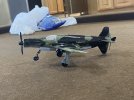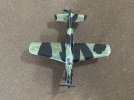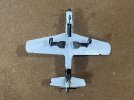Hi guys,
I figured it’s time I ask a potentially difficult question.
First some context. It’s been very hot here where I live. As a result, the paint that I bought for the model airplane I was building has been drying really fast. Same with the glue. I was actually really surprised. As a result, I was able to work on it a little bit faster than anticipated.
BEFORE I put on the decals, I wanted to show you all my progress. Please keep in mind, it’s my first model airplane that I have built in years.
It’s a 1:72 Dornier Do 335.




In my mind, I think the camouflage color that is too dark can be a little lighter, but darker than the green. I also think that I need to work on the tail a little bit more when it comes to painting.
What do you guys think? Any room for improvement?
Regards,
Jared
I figured it’s time I ask a potentially difficult question.
First some context. It’s been very hot here where I live. As a result, the paint that I bought for the model airplane I was building has been drying really fast. Same with the glue. I was actually really surprised. As a result, I was able to work on it a little bit faster than anticipated.
BEFORE I put on the decals, I wanted to show you all my progress. Please keep in mind, it’s my first model airplane that I have built in years.
It’s a 1:72 Dornier Do 335.




In my mind, I think the camouflage color that is too dark can be a little lighter, but darker than the green. I also think that I need to work on the tail a little bit more when it comes to painting.
What do you guys think? Any room for improvement?
Regards,
Jared
